1838 - John Muir's Birthplace
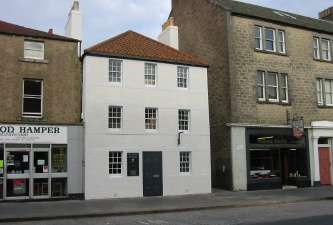
John Muir was born in the town of Dunbar, East Lothian, Scotland, on April
21, 1838 to Daniel Muir and Ann Gilrye. The house in which he was born has
been preserved as a museum. "When I was
a boy in Scotland," Muir would later recall, "I was fond of everything that
was wild ... I loved to wander in the fields to hear the birds sing, and along
the shore to gaze and wonder at the shells and the seaweeds, eels and crabs
in the pools when the tide was low; and best of all to watch the waves in awful
storms thundering on the black headlands and craggy ruins of old Dunbar Castle." Today,
a 51-km trail called John Muir Way retraces some of that terrain.
1849 - Fountain Lake Farm, Wisconsin
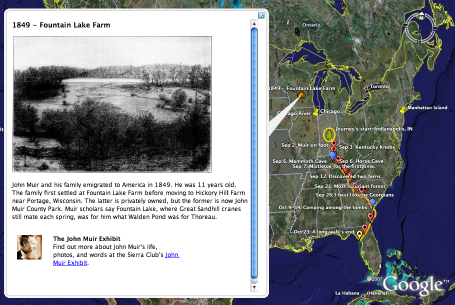
John Muir and his family emigrated to America in 1849. He was 11 years old.
The family first settled at Fountain Lake Farm before moving to Hickory Hill
Farm near Portage, Wisconsin. The latter is privately owned, but the former
is now John Muir County Park. Muir scholars say Fountain Lake, where Great
Sandhill cranes still mate each spring, was for him what Walden Pond was for Thoreau.
1867 - A Thousand-Mile Walk to the Gulf
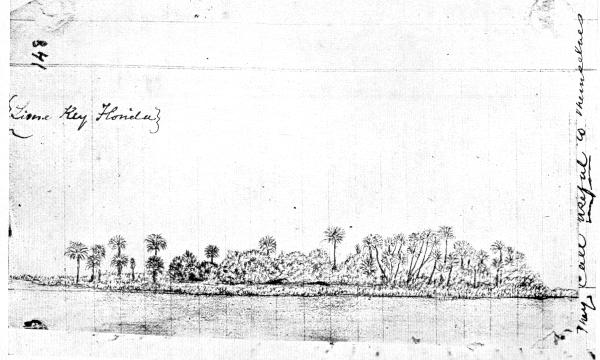
Muir made his great "floral pilgrimage" in 1867 after being temporarily blinded in an industrial accident. "My plan," Muir would later write in his 1916 book, A Thousand-Mile
Walk to the Gulf, "was simply to push on in a general southward direction
by the wildest, leafiest, and least trodden way I could find, promising the
greatest extent of virgin forest." As his eyesight returned, Muir hoped to travel to South America and the Amazon, but illness
-- probably malaria -- altered his plans and he headed for California, by
way of Panama, instead.
1868 - Yosemite Valley
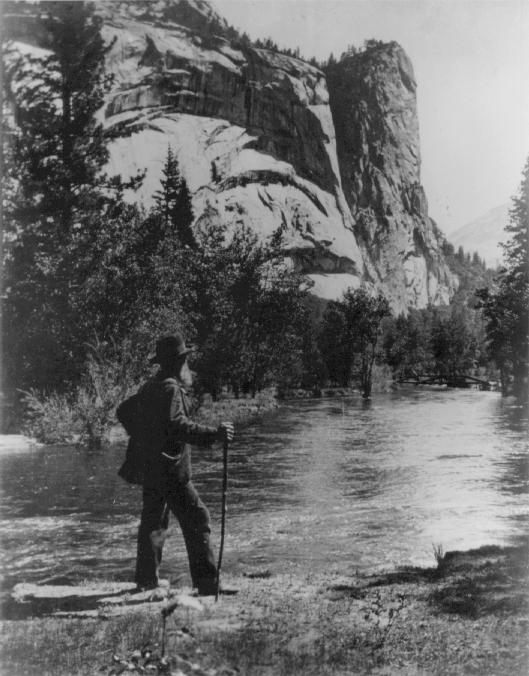
Upon arriving in San Francisco in 1868, Muir headed straight for Yosemite
Valley and was immediately overwhelmed by its beauty. As he described it in A Thousand-Mile
Walk to the Gulf, "The walls are made up of rocks, mountains in size,
partly separated from each other by side cañons, and they are so sheer
in front, and so compactly and harmoniously arranged on a level floor, that
the Valley, comprehensively seen, looks like an immense hall or temple lighted
from above. But no temple made with hands can compare with Yosemite." He
spent the following summer in the mountains around Yosemite working as a
sheep herder and eventually built himself a cabin on Yosemite Creek. Of all
the places Muir traveled, none is as closely associated with his memory as
Yosemite Valley.
1871 - Hetch Hetchy
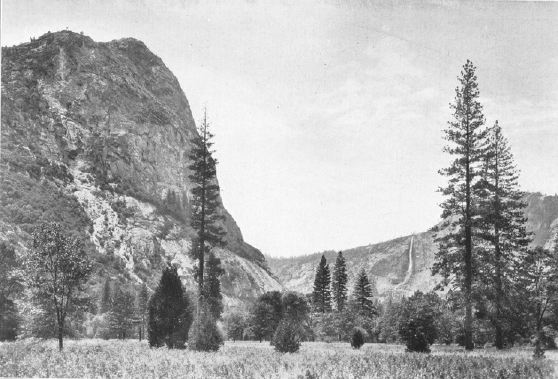
John Muir first laid eyes on Hetch
Hetchy Valley in 1871 and found it to be "a wonderfully exact counterpart" to
Yosemite. As San Francisco grew, pressure to dam the Tuolumne River to supply
the city's water needs grew. For years Muir and the Sierra Club rallied against
the project, but the bill to complete it was eventually signed by Woodrow Wilson
a year before Muir's death in 1914. It has been suggested that Muir, who
dearly loved Hetch Hetchy, died of a broken heart. The Sierra Club still
hopes to
see the O'Shaughnessy Dam dismantled and the valley restored.
1872 - No Small Challenge: Climbing Mt Ritter

John Muir made the first ascent of 13,300-foot Mount Ritter in October of 1872. As is clear from his report, the summit posed no small challenge. "After gaining a point about half-way to the top, I was brought to a dead stop, with arms outspread, clinging close to the face of the rock, unable to move hand or foot either up or down. My doom appeared fixed. I must fall. ... When this final danger flashed in upon me, I became nerve-shaken for the first time since setting foot on the mountain, and my mind seemed to fill with a stifling smoke. But the terrible eclipse lasted only a moment, when life burst forth again with preternatural clearness. ... Then my trembling muscles became firm again, every rift and flaw was seen as through a microscope, and my limbs moved with a positiveness and precision with which I seemed to have nothing at all to do."
1879 - Muir Glacier
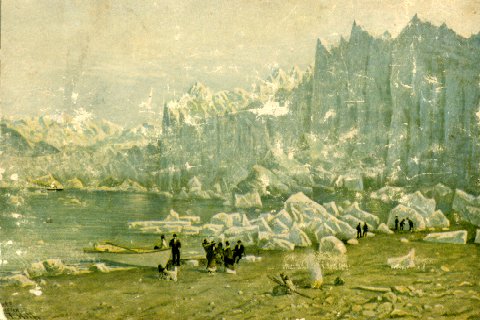
Muir Glacier is a 2-mile-wide tidewater glacier, the terminus of which calves into Muir Inlet in Glacier Bay. When George Vancouver visited the area in 1794, passage to the bay was blocked by ice. By the time Muir visited in 1879, the ice had receded more than 30 miles inland. An account of his discovery is included in Travels
in Alaska, which was published in 1915, a year after his death. Glacier Bay became a national park and preserve in 1980.
1880 - A Home in Martinez, California
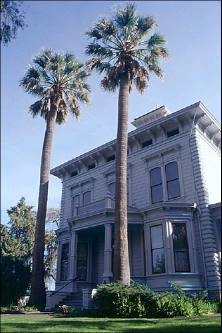
On April 14, 1880 Muir, who once fretted that he should forever remain a bachelor
and "wander far outside the family circle," married
Louie Wanda Strentzel, the daughter of a Polish immigrant who had become a
successful fruit farmer and vintner in the San Francisco Bay Area. John Muir
and his wife settled in the East Bay town of Martinez, in a 14-room Victorian
house on the Strentzel family ranch. One of those rooms was
the famous "scribble den," in which Muir labored away on his many books and
articles. The house is now a national historic site, administered by the
National Park Service.
1880 - An Adventure with Stickeen
Brady Glacier empties into Taylor Bay in what is now Glacier Bay National Park. This was the site of Muir's 1880 adventure with Stickeen, a four-legged companion Muir would later immortalize in his writings, including Travels
in Alaska and, as a longer treatment, in Stickeen:
Story of a Dog. The latter is among the most popular of Muir's books and recounts his harrowing adventures on the glacier and the sense of kinship he developed for his "horizontal brother."
1905 - Glacier Point with Teddy Roosevelt
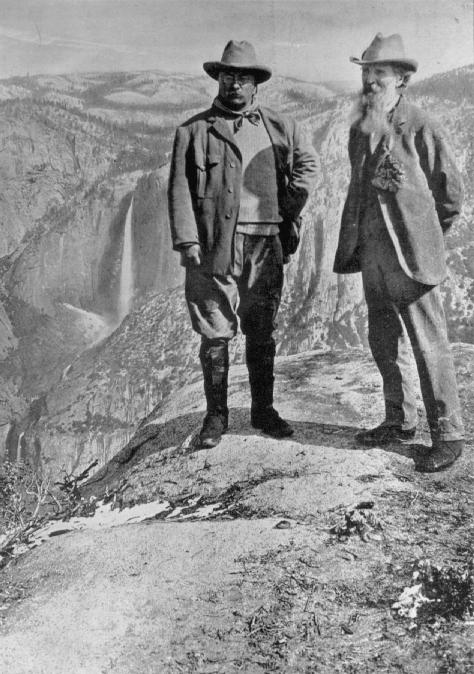
Widely regarded as the father of the national parks, John Muir devoted most
of his adult life to the
preservation of wilderness. In 1903, more than a decade after the founding
of the Sierra Club, Muir joined President Theodore Roosevelt on a visit to
Yosemite Valley, which was then a state park and suffering from mismanagement.
Muir and Roosevelt spent a night in the backcountry, sharing a campfire and
sleeping under the stars. They were photographed together at Glacier Point.
Muir convinced Roosevelt that the area required greater protection
and, two years later, in 1905, Yosemite Valley and Mariposa Grove were placed
under the jurisdiction of the National Park Service. After Muir's death, Roosevelt
wrote an appreciation of his old friend for Outlook magazine: "It
was my good fortune to know John Muir," the former President wrote. "He was,
and continues to be, the most influential and important naturalist in America's
history."
Roosevelt's
appreciation